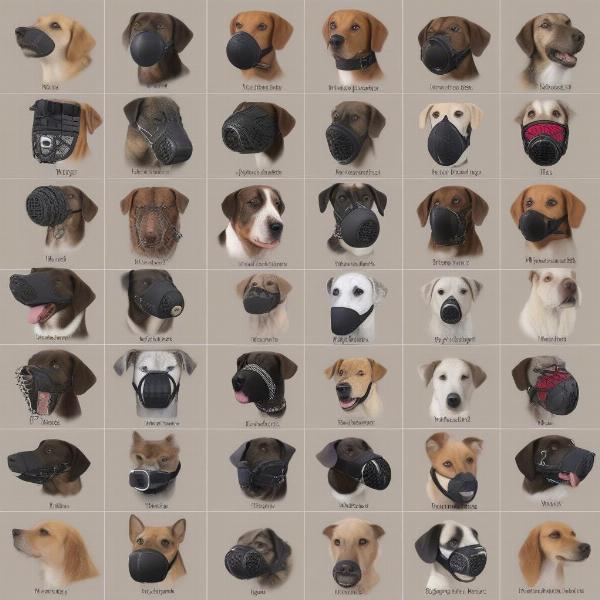A dog wearing a muzzle often evokes mixed reactions. While some may associate muzzles with aggression, the truth is much more nuanced. Dog with muzzle can actually be a sign of responsible ownership, ensuring the safety of both the dog and those around it. This article will explore the various reasons why a dog might wear a muzzle, how to properly introduce and train a dog to accept a muzzle, and how to choose the right type of muzzle for your furry friend.
Why Dogs Wear Muzzles: Debunking the Myths
It’s important to understand that a dog with muzzle isn’t necessarily aggressive. There are many legitimate reasons why a responsible owner might choose to muzzle their dog. These include:
- Veterinary visits: A muzzle can prevent a dog in pain or distress from biting during examinations or procedures.
- Grooming: Some dogs become anxious or uncomfortable during grooming, and a muzzle can protect the groomer from potential bites.
- Safety in public spaces: In crowded areas or situations where a dog might feel overwhelmed, a muzzle can provide an extra layer of safety. cane corso dog muzzle
- Training for reactivity: Muzzles can be used as a training tool to help manage reactivity towards other dogs or people.
- Preventing scavenging: A muzzle can prevent a dog from picking up and eating potentially harmful items off the ground.
- Legal requirements: Some jurisdictions may require certain breeds to be muzzled in public.
Choosing the Right Muzzle: A Guide to Different Types
 Different types of dog muzzles
Different types of dog muzzles
Selecting the appropriate muzzle is crucial for your dog’s comfort and safety. Here’s a breakdown of common muzzle types:
- Basket muzzles: These allow for panting, drinking, and even taking treats, making them a comfortable option for extended wear. dog muzzle for short snout
- Soft muzzles: Typically made of nylon or mesh, these are lightweight and less restrictive, but don’t allow for panting or drinking. They are best suited for short-term use.
- Short snout muzzles: Designed specifically for brachycephalic breeds like Bulldogs and Pugs, these muzzles provide adequate ventilation while accommodating their shorter noses. dog muzzle for mastiff
Introducing the Muzzle: Positive Reinforcement is Key
Introducing a muzzle should be a gradual and positive process. Start by letting your dog sniff and investigate the muzzle. Then, begin associating the muzzle with positive experiences, such as treats and praise. Gradually increase the duration of time your dog wears the muzzle, ensuring they remain comfortable throughout the process. great dane dog muzzle
“Positive reinforcement is the most effective way to acclimate a dog to a muzzle,” says Dr. Emily Carter, DVM, a certified veterinary behaviorist. “By creating a positive association, the dog will learn to view the muzzle as a non-threatening and even enjoyable experience.”
Living with a Muzzled Dog: Tips for Owners
A dog with a muzzle can still live a full and happy life. Regular exercise, socialization, and mental stimulation are just as important for muzzled dogs as they are for any other dog. Just remember to choose activities that are safe and appropriate, and always supervise your dog while they are wearing a muzzle. best dog muzzle uk
“Never leave a muzzled dog unattended,” advises Karen Miller, a certified professional dog trainer. “Even with the most well-fitted muzzle, there’s always a potential risk, so supervision is crucial.”
Conclusion
Understanding the reasons behind a dog wearing a muzzle is key to breaking down the stigma. By choosing the right muzzle, introducing it positively, and continuing to provide a stimulating and enriching environment, owners can ensure that their muzzled dogs remain happy, healthy, and safe members of the community.
FAQ
- Are muzzles cruel? No, when used correctly, muzzles are not cruel. They can actually be a humane way to manage certain behaviors and ensure safety.
- Can my dog pant and drink while wearing a muzzle? Yes, basket muzzles allow for panting, drinking, and even taking treats.
- How do I choose the right size muzzle for my dog? Measure your dog’s snout circumference and length to ensure a proper fit.
- Can muzzles be used for punishment? No, muzzles should never be used as a form of punishment.
- How long can my dog wear a muzzle? This depends on the type of muzzle and the individual dog. Consult with a veterinarian or trainer for specific recommendations.
- Are there certain breeds that shouldn’t wear muzzles? Brachycephalic breeds require specially designed muzzles to ensure proper ventilation.
- What if my dog tries to paw off the muzzle? This could indicate discomfort or improper fit. Consult a trainer for guidance.
About ILM Dog
ILM Dog is your trusted global resource for all things dog-related. We offer expert advice on breeds, health, training, nutrition, grooming, and much more. Whether you’re a new dog owner or a seasoned pro, ILM Dog provides practical and reliable information to help you navigate every aspect of dog ownership. Contact us for personalized guidance: Email: [email protected], Phone: +44 20-3965-8624.